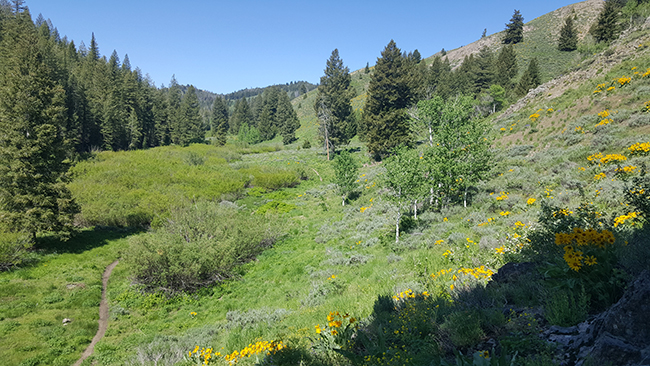
‘Pack it in, Pack it out’
BY TRISTAN HEAD
This is not an all-encompassing overview of trail etiquette; the U.S. Forest Service and other federal agencies should be sought out for further information.
My wife sauntered toward the waterfall, distracted by all else in our world. Yet, flies hovering a foot off the ground drew my attention. I suddenly shoved her to the side. Someone. Someone had left a disgusting, streaming gift to commemorate the ground in their presence right to the side of the viewpoint. If you have explored the greater Stanley area lately, you may notice this has become commonplace. While my five-year-old has grown accustomed to digging a hole to hover over, I recognize the individuals who left their fecal matter uncovered maybe didn’t know proper etiquette.
COVID arrived bringing in its wake an unprecedented change to the outdoor industry. In 2022 the Outdoor Industry Association found that there was a growth of 2.3% in outdoor recreationists, which doesn’t seem astronomical until you consider that it doubles Idaho’s population. When the math is added up, outdoor enthusiasts represent 168.1 million individuals. The tremendous addition encompasses a population that isn’t familiar with “mountain culture” or loose guidelines revolving around interactions with the wilderness. Yet with this growth has come aching pains: Increased crowds. Noise. Toilet paper. Trodden flora. Dogs chasing wildlife. Here are two aspects of trail etiquette to ensure that every person has an enjoyable and inclusive experience on the trail.
Leave No Trace – When heading out, preparation is vital, which includes preparing to go to the bathroom. To begin, you need to be at least 200 yards away from any trail, campsite, or water source to ensure you don’t contaminate the water (you’ll appreciate this rule when you get thirsty later). Kula Cloth, a reusable antimicrobial pee cloth, has the ladies covered, but what happens when you need something a little more substantial? Some individuals carry small trowels to dig holes whereas others opt for the lighter method of a rock or sturdy stick. Strive to dig your hole 8 inches deep with a width of at least 4 inches to allow for any excess to be consolidated before thoroughly burying.
While toilet paper consists of biodegradable wood pulp, consider where you are going to the bathroom. Sometimes the right decision isn’t the guideline, yet requires the individual to consider the environment where their fecal matter and “booty buddy” will decompose. Some will argue, “You pack it in, you pack it out,” which includes any fecal matter or tampons. In this case, bring along a gallon-sized freezer bag or turn your freeze-dried food into a multi-use bag! Plastic jars with sealable lids make another tremendous alternative and are more resilient than baggies.
Delving further into “Pack it in, Pack it out!” means that all wrappers, bullet casings, and orange peels need to leave the forest with you. This should be easy to follow, yet garbage is prominent in some of the most remote regions of the country, including our beloved Frank Church–River of No Return Wilderness. I challenge you to pick up a few pieces of garbage you see on excursions or even locally and pack them out, leaving these areas in better condition than when you arrived.
Leave No Trace does incorporate painted rocks. The National Park Service states, “Chalking, carving, scratching, or painting on rocks, trees, and other natural objects is considered graffiti and is illegal. It degrades the environment and the experience for all.” They also elaborate on stacking rocks, “…removal of rocks from waterways can alter streamflow and displace aquatic life, like mayflies and stoneflies,” which make up a vast majority of a trout’s diet. The final comment on rocks revolves around building cairns. Cairns represent trail markers in diligently chosen locations rather than sporadic areas which can divert inexperienced as well as experienced hikers from trails.
Lastly, cleaning. Remember that after a long day any use of insect repellent, soaps, sunscreens, etc., can contaminate waterways, so please cleanse yourself at least 200 yards away or in designated areas; wet wipes do an excellent job but unless labeled, they aren’t biodegradable. Be sure to pack them out.
Yielding – Yielding is not nearly as simple as rules may convey due to the many unwritten rules. These include always yielding to horses while making eye contact and talking to horseback riders or solo hikers yielding to groups causing less stress on flora bordering trails. Regardless, here are a few basics:
• Downhill traffic yields to uphill everywhere, including steep, single-lane roads like Trail Creek
• Bikers yield to both hikers, and horses and stock
• Hikers yield to horses and stock – when you encounter horses or stock, step to the side in a slow, controlled manner while engaging with the individuals to explain what you are doing or even ask which side of the trail to move to. Also, please ensure you have your dog(s) under control so no one gets injured
Everyone is welcome in the wilderness, but within this invitation lies a responsibility to learn how to mitigate impact. This ensures future generations can enjoy a similar, pristine environment. If you witness someone conducting an act that may impact the environment negatively, engage in a friendly conversation conveying the various aspects of your personal experiences.
Want to learn more? Visit www.lnt.org, nps.gov, or your local rangers at the SNRA.


